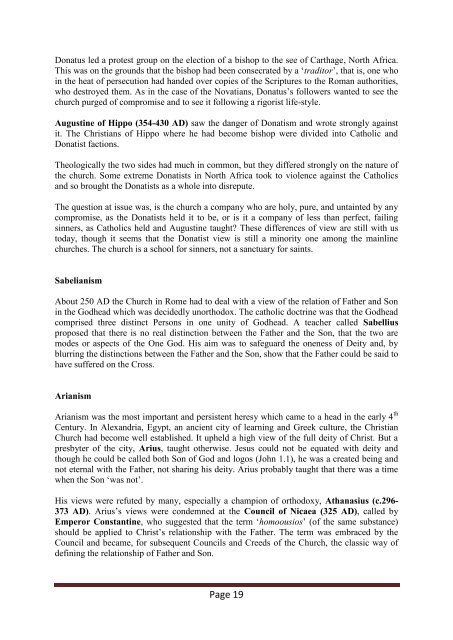Digging Out the Embedded Church - The Maranatha Community
Digging Out the Embedded Church - The Maranatha Community
Digging Out the Embedded Church - The Maranatha Community
You also want an ePaper? Increase the reach of your titles
YUMPU automatically turns print PDFs into web optimized ePapers that Google loves.
Donatus led a protest group on <strong>the</strong> election of a bishop to <strong>the</strong> see of Carthage, North Africa.<br />
This was on <strong>the</strong> grounds that <strong>the</strong> bishop had been consecrated by a „traditor‟, that is, one who<br />
in <strong>the</strong> heat of persecution had handed over copies of <strong>the</strong> Scriptures to <strong>the</strong> Roman authorities,<br />
who destroyed <strong>the</strong>m. As in <strong>the</strong> case of <strong>the</strong> Novatians, Donatus‟s followers wanted to see <strong>the</strong><br />
church purged of compromise and to see it following a rigorist life-style.<br />
Augustine of Hippo (354-430 AD) saw <strong>the</strong> danger of Donatism and wrote strongly against<br />
it. <strong>The</strong> Christians of Hippo where he had become bishop were divided into Catholic and<br />
Donatist factions.<br />
<strong>The</strong>ologically <strong>the</strong> two sides had much in common, but <strong>the</strong>y differed strongly on <strong>the</strong> nature of<br />
<strong>the</strong> church. Some extreme Donatists in North Africa took to violence against <strong>the</strong> Catholics<br />
and so brought <strong>the</strong> Donatists as a whole into disrepute.<br />
<strong>The</strong> question at issue was, is <strong>the</strong> church a company who are holy, pure, and untainted by any<br />
compromise, as <strong>the</strong> Donatists held it to be, or is it a company of less than perfect, failing<br />
sinners, as Catholics held and Augustine taught? <strong>The</strong>se differences of view are still with us<br />
today, though it seems that <strong>the</strong> Donatist view is still a minority one among <strong>the</strong> mainline<br />
churches. <strong>The</strong> church is a school for sinners, not a sanctuary for saints.<br />
Sabelianism<br />
About 250 AD <strong>the</strong> <strong>Church</strong> in Rome had to deal with a view of <strong>the</strong> relation of Fa<strong>the</strong>r and Son<br />
in <strong>the</strong> Godhead which was decidedly unorthodox. <strong>The</strong> catholic doctrine was that <strong>the</strong> Godhead<br />
comprised three distinct Persons in one unity of Godhead. A teacher called Sabellius<br />
proposed that <strong>the</strong>re is no real distinction between <strong>the</strong> Fa<strong>the</strong>r and <strong>the</strong> Son, that <strong>the</strong> two are<br />
modes or aspects of <strong>the</strong> One God. His aim was to safeguard <strong>the</strong> oneness of Deity and, by<br />
blurring <strong>the</strong> distinctions between <strong>the</strong> Fa<strong>the</strong>r and <strong>the</strong> Son, show that <strong>the</strong> Fa<strong>the</strong>r could be said to<br />
have suffered on <strong>the</strong> Cross.<br />
Arianism<br />
Arianism was <strong>the</strong> most important and persistent heresy which came to a head in <strong>the</strong> early 4 th<br />
Century. In Alexandria, Egypt, an ancient city of learning and Greek culture, <strong>the</strong> Christian<br />
<strong>Church</strong> had become well established. It upheld a high view of <strong>the</strong> full deity of Christ. But a<br />
presbyter of <strong>the</strong> city, Arius, taught o<strong>the</strong>rwise. Jesus could not be equated with deity and<br />
though he could be called both Son of God and logos (John 1.1), he was a created being and<br />
not eternal with <strong>the</strong> Fa<strong>the</strong>r, not sharing his deity. Arius probably taught that <strong>the</strong>re was a time<br />
when <strong>the</strong> Son „was not‟.<br />
His views were refuted by many, especially a champion of orthodoxy, Athanasius (c.296-<br />
373 AD). Arius‟s views were condemned at <strong>the</strong> Council of Nicaea (325 AD), called by<br />
Emperor Constantine, who suggested that <strong>the</strong> term „homoousios‟ (of <strong>the</strong> same substance)<br />
should be applied to Christ‟s relationship with <strong>the</strong> Fa<strong>the</strong>r. <strong>The</strong> term was embraced by <strong>the</strong><br />
Council and became, for subsequent Councils and Creeds of <strong>the</strong> <strong>Church</strong>, <strong>the</strong> classic way of<br />
defining <strong>the</strong> relationship of Fa<strong>the</strong>r and Son.<br />
Page 19








